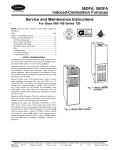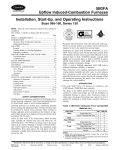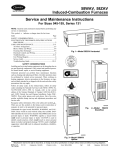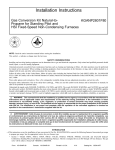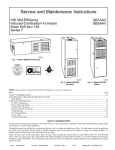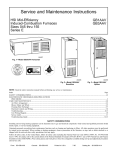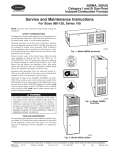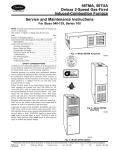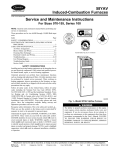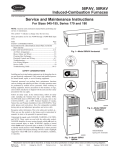Download Carrier INDUCED COMBUSTION FURNACES 58GFA Instruction manual
Transcript
58GFA Induced Combustion Furnaces Service and Maintenance Instructions For Sizes 065-150 Series 130 NOTE: Read the entire instruction manual before starting the installation. These procedures are for sizes 65,000 through 150,000 Btuh units. Index Page SAFETY CONSIDERATIONS .....................................................1 CARE AND MAINTENANCE..................................................1-4 Air Filter Arrangement .............................................................2 Blower Motor and Wheel......................................................2-3 Cleaning Heat Exchanger......................................................3-4 Electrical Controls and Wiring.................................................4 Pilot ...........................................................................................4 Troubleshooting ........................................................................4 Unit Wiring Diagram ............................................................5-6 Troubleshooting Chart ..............................................................7 SAFETY CONSIDERATIONS Installing and servicing heating equipment can be hazardous due to gas and electrical components. Only trained and qualified personnel should install, repair, or service heating equipment. Untrained personnel can perform basic maintenance functions such as cleaning and replacing air filters. All other operations must be performed by trained service personnel. When working on heating equipment, observe precautions in the literature, on tags, and on labels attached to or shipped with the unit and other safety precautions that may apply. Follow all safety codes. In the United States, follow all safety codes including the National Fuel Gas Code NFPA No. 541992/ANSI Z223.1-1992 (NFGC). In Canada, refer to the current edition of the National Standard of Canada CAN/CGA-B149.1and .2-M95 Natural Gas and Propane Gas Installation Codes (NSCNGPIC). Wear safety glasses and work gloves. Have fire extinguisher available during start-up and adjustment procedures and service calls. Recognize safety information. This is the safety-alert symbol . When you see this symbol on the furnace and in instructions or manuals, be alert to the potential for personal injury. Understand the signal word DANGER, WARNING, or CAUTION. These words are used with the safety-alert symbol. DANGER identifies the most serious hazards which will result in severe personal injury or death. WARNING signifies a hazard that could result in personal injury or death. CAUTION is used to identify unsafe practices which would result in minor personal injury or product and property damage. NOTE is used to highlight suggestions that will result in enhanced installation, reliability, or operation. ® ama CANADIAN GAS ASSOCIATION A PP R O VED R A92057 Fig. 1—Model 58GFA Upflow The ability to properly perform maintenance on this equipment requires certain expertise, mechanical skills, tools and equipment. If you do not possess these, do not attempt to perform any maintenance on this equipment other than those procedures recommended in the User’s Manual. FAILURE TO FOLLOW THIS WARNING COULD RESULT IN POSSIBLE DAMAGE TO THIS EQUIPMENT, SERIOUS PERSONAL INJURY, OR DEATH. CARE AND MAINTENANCE For continuing high performance and to minimize possible equipment failure, it is essential that periodic maintenance be performed on this equipment. Consult your local dealer as to the proper frequency of maintenance and the availability of a maintenance contract. Manufacturer reserves the right to discontinue, or change at any time, specifications or designs without notice and without incurring obligations. Book 1 4 PC 101 Catalog No. 535-821 Printed in U.S.A. Form 58GFA-1SM Pg 1 10-95 Replaces: 58D, G-3SM Tab 6a 8a MOUNTING SCREWS Turn off the gas and electrical supplies to the unit before performing any maintenance or service. Follow the operating instructions on the label attached to the furnace. A failure to follow this warning could result in personal injury. DRAFT SAFEGUARD SWITCH RELIEF BOX Never store anything on, near, or in contact with the furnace, such as: 1. Spray or aerosol cans, rags, brooms, dust mops, vacuum cleaners or other cleaning tools. 2. Soap powders, bleaches, waxes or other cleaning compounds, plastic or plastic containers, gasoline, kerosene, cigarette lighter fluid, dry cleaning fluids or other volatile fluids. 3. Paint thinners and other painting compounds, paper bags or other paper products. A failure to follow this warning could result in corrosion of the heat exchanger, fire, personal injury, or death. GAS VALVE PILOT CONTROL BOX FILTER RETAINER The minimum maintenance that should be performed on this equipment is as follows: WASHABLE FILTER 1. Check and clean air filter each month or more frequently if required. Replace if torn. 2. Check blower motor and wheel for cleanliness and lubrication each heating and cooling season. Clean and lubricate as necessary. A92178 Fig. 2—Model 58GFA Upflow 3. Check electrical connections for tightness and controls for proper operation each heating season. Service as necessary. d. Slide filter out. e. Furnaces are equipped with permanent, washable filters. Clean filters with tap water. Spray water through filter in opposite direction of airflow. As with any mechanical equipment, personal injury can result from sharp metal edges, etc., therefore, be careful when removing parts. f. Rinse and let dry. Oiling or coating of filter is not recommended or required. AIR FILTER ARRANGEMENT g. Reinstall filter. The air filter arrangement may vary depending on the application. Refer to Table 1 for filter size information. h. Replace access doors. i. Restore electrical power to furnace. Table 1—Filter Size Information (In.) FURNACE CASING WIDTH 14-3/16 17-1/2 21 24-1/2 FILTER QUANTITY AND SIZE Side Return Bottom Return (1) 16 X 25 X 1* (1) 14 X 25 X 1 (1) 16 X 25 X 1* (1) 16 X 25 X 1 (1) 16 X 25 X 1 (1) 20 X 25 X 1* (2) 16 X 25 X 1* (1) 24 X 25 X 1 FLUE COLLECTOR BOX BLOWER MOTOR AND WHEEL FILTER TYPE For long life, economy, and high efficiency, clean accumulated dirt and grease from the blower wheel and motor annually. Cleanable Cleanable Cleanable Cleanable The following steps should be performed by a qualified service technician: Some motors have prelubricated sealed bearings and require no lubrication. These motors can be identified by the absence of oil ports on each end of the motor. For those motors with oil ports, lubricate motor every 5 years if motor is used on intermittent operation (thermostat FAN switch in AUTO position), or every 2 years if motor is in continuous operation (thermostat FAN switch in ON position). * Factory-provided with the furnace. Filters may be field modified by cutting as required. Never operate unit without a filter or with filter access door removed. A failure to follow this warning could result in fire, personal injury or death. Remember to disconnect the electrical supply before removing access doors. 1. Each furnace requires 1 or 2 filters which are installed in the blower compartment. (See Fig. 2.) Clean and lubricate as follows: To remove filters for cleaning or replacement, proceed as follows: a. Disconnect electrical power before removing access doors. 2. Remove control assembly. b. Remove blower and control access doors. 4. Remove screws holding blower assembly to blower deck and slide blower assembly out of furnace. 3. Remove blower leads from blower assembly. Note location of wires for reassembly. c. Release filter retainer from clip at front of furnace casing. (See Fig. 2.) For side return, clips may be used on either or both sides of the furnace. 5. Loosen screw in strap holding motor capacitor to blower housing and slide capacitor out from under strap. 2 6. Mark blower wheel, motor, and motor support in relation to blower housing before disassembly to ensure proper reassembly. e. Gas valve f. Edge connector leading to control box 7. Loosen setscrew holding blower wheel on motor shaft. 4. Remove 8 screws that secure flue collector box to center panel. Be careful not to damage sealant. 8. Remove bolts holding motor mount to blower housing and slide motor and mount out of housing. Disconnect ground wire attached to blower housing before removing motor. 5. Remove complete inducer assembly from furnace, exposing flue openings. 9. Lubricate motor (when oil ports are provided). 6. Clean cells using field-provided small wire brush, steel spring cable, reversible electric drill, and vacuum cleaner. a. Remove dust caps or plugs from oil ports located at each end of motor. a. Assemble wire brush and steel spring cable. b. Use a good grade of SAE 20 nondetergent motor oil and put 1 teaspoon, 5 cc, 3/16 oz, or 16 to 25 drops in each oil port. Do not over-oil. (1.) Use 48 in. of 1/4-in. diameter high-grade steel spring cable (commonly known as drain clean-out or RotoRooter cable). c. Allow time for total quantity of oil to be absorbed by each bearing. (2.) Use 1/4-in. diameter wire brush (commonly known as 25-caliber rifle cleaning brush). NOTE: The items needed in steps (1.) and (2.) can usually be purchased at local hardware stores. d. Wipe excess oil from motor housing. e. Replace dust caps or plugs on oil ports. (3.) Insert twisted wire end of brush into end of steel spring cable, and crimp tight with crimping tool or strike with ball-peen hammer. TIGHTNESS is very important. 10. Remove blower wheel from housing. a. Mark cutoff location to ensure proper reassembly. b. Remove screws holding cutoff plate and remove cutoff plate from housing. (4.) Remove metal screw fitting from wire brush to allow insertion into cable. c. Lift blower wheel from housing through opening. b. Clean each heat exchanger cell. 11. Clean blower wheel and motor using a vacuum cleaner with soft brush attachment. Do not remove or disturb balance weights (clips) on blower wheel blades. The blower wheel should not be dropped or bent as balance will be affected. (1.) Attach variable-speed, reversible drill to end of steel spring cable (end opposite brush). (2.) Insert brush end of cable into upper opening of cell and slowly rotate with drill. DO NOT force cable. Gradually insert at least 36 in. of cable into 2 upper passes of cell. (See Fig. 3.) 12. Reinstall blower wheel by reversing steps 9 a. through c. Be sure wheel is positioned for proper rotation. 13. Reassemble motor and blower by reversing steps 2 through 7. If motor has ground wire, be sure it is connected as before. Be sure the motor is properly positioned in the blower housing. The motor oil ports must be at a minimum of 45° above the horizontal centerline of the motor after the blower assembly has been reinstalled in the furnace. 14. Reinstall blower assembly in furnace. Connect blower leads to blower speed selector. 15. Reinstall control assembly. 16. Turn on electrical power and check for proper rotation and speed changes between heating and cooling. A91252 17. Replace blower access door. Fig. 3—Cleaning Heat Exchanger Cell CLEANING HEAT EXCHANGER The following steps should be performed by a qualified service technician: NOTE: Deposits of soot and carbon indicate the existence of a problem which needs to be corrected. Take action to correct the problem. (3.) Work cable in and out of cell 3 or 4 times to obtain sufficient cleaning. DO NOT pull cable with great force. Reverse drill and gradually work cable out. (4.) Remove burner assembly and cell inlet plates. (5.) Replace screws in center panel and cells before cleaning. If it becomes necessary to clean the heat exchanger because of carbon deposits, soot, etc., proceed as follows: (6.) Insert brush end of cable in lower opening of cell, and proceed to clean 2 lower passes of cell in same manner as 2 upper passes. 1. Turn off gas and electrical power to furnace. 2. Remove 2 screws that secure relief box. (See Fig. 3.) 3. Disconnect wires to the following components: a. Draft safeguard switch (7.) Repeat foregoing procedures until each cell in furnace has been cleaned. b. Inducer motor (8.) Remove residue from each cell using vacuum cleaner. c. Pressure switch (9.) Clean burner assembly using vacuum cleaner with soft brush attachment. d. Limit overtemperature switch 3 (10.) Reinstall cell inlet plates and burner assembly. Care must be exercised to center the burners in the cell openings. PILOT HEAD V–NOTCH FALLS DIRECTLY BELOW FRONT EDGE OF BURNER CARRYOVER. 7. After cleaning flue openings, check sealant on flue collector to ensure that it has not been damaged. If new sealant is needed, contact your dealer or distributor. 8. Clean and replace flue collector assembly, making sure all 8 screws are secure. 1/8″ 9. Reinstall 2 screws in relief box. 10. Reconnect wires to the following components: a. Draft safeguard switch b. Inducer motor c. Pressure switch A91249 d. Limit overtemperature switch Fig. 4—Position of Pilot to Burner e. Gas valve securely. Electrical controls are difficult to check without proper instrumentation; therefore, reconnect electrical power to unit and observe unit through 1 complete operating cycle. f. Edge connector leading to control box 11. Replace blower access doors. 12. Turn on electrical power and gas. The 24-v circuit contains an automotive-type, 3-amp fuse located on the main control board. Any direct shorts during installation, service, or maintenance could cause this fuse to blow. If fuse replacement is required, use ONLY a 3-amp fuse of identical size. 13. Set thermostat and check furnace for proper operation. PILOT Never use a match or other open flame to check for gas leaks. Use a soap-and-water solution. A failure to follow this warning could result in fire, personal injury or death. Check the pilot and clean if necessary at the beginning of each heating season. The pilot flame should be high enough for proper impingement of the flame sensing element (or thermocouple) and to light the burners. Remove the accumulation of soot and carbon from the flame sensing element (or thermocouple). Refer to Fig. 4 for proper location of pilot on burner assembly. 14. Check for gas leaks. 15. Replace control access door. ELECTRICAL CONTROLS AND WIRING NOTE: There may be more than 1 electrical supply to unit. TROUBLESHOOTING The electrical ground for 115-v wiring must be maintained properly. Refer to Fig. 5 for field wiring information and to Fig. 6 for unit wiring information. Page 7 contains a troubleshooting chart. This chart can be a useful tool in isolating furnace operation problems. Beginning with the word "Start," answer each question and follow the appropriate arrow to the next item. With power disconnected to unit, check all electrical connections for tightness. Tighten all screws on electrical connections. If any smoky or burned connections are noticed, disassemble the connection, clean all parts and stripped wire, and reassemble properly and The chart will help identify the problem or failed component. After replacing any component, verify correct operating sequence as indicated by bold arrows. 4 FIELD 24-VOLT WIRING FIELD 115-, 208/230-, 460-VOLT WIRING FACTORY 24-VOLT WIRING FACTORY 115-VOLT WIRING NOTE 2 W FIVE WIRE C R G Y THERMOSTAT TERMINALS FIELD-SUPPLIED FUSED DISCONNECT THREE-WIRE HEATINGONLY BLK BLK W WHT WHT R GND GND 115-VOLT FIELD- AUXILIARY J-BOX SUPPLIED CONTROL FUSED BOX DISCONNECT 208/230- OR 460-VOLT THREE PHASE G C GND NOTE 1 CONDENSING UNIT Y 24-VOLT TERMINAL BLOCK FURNACE 208/230VOLT SINGLE PHASE TWO WIRE NOTES: 1. Connect Y-terminal as shown for proper operation. 2. Some thermostats require a "C" terminal connection as shown. 3. If any of the original wire, as supplied, must be replaced, use same type or equivalent wire. A95241 Fig. 5—Heating and Cooling Application Wiring Diagram 5 GV CONNECTION DIAGRAM DSS MGV TH TR PRS L1 NO BRN L2 TO 115V AC FIELD DISCONNECTIONS ILK C SCHEMATIC DIAGRAM NOTE #4 NC EQUIPMENT GROUND PILOT L1 LS FL ALS SPARE-1 NOTE #9 IDM (WHEN USED) NOTE #6 PL1-3 RED BLU WHT 115V AC LS FL ALS GRN CAP BRN PR2 L2 START YEL WHT RED RED BLU BRN ORN BLK BLU RED BLK PL1 1 4 7 2 5 8 3 6 9 L1 PR1 CFR HFR EAC-1 SEC-2 HFR R LOGIC PL1-9 TIME DELAY MGV DSS BLK (HI) GV SPARE-1 YEL (MED HI) SPARE-2 Y IDR NOTE #9 RED BLU NO NC SEC-2 SEC-1 RED (LO) W Y R C G PCB 3AMP FUSE NOTE #7 NOTE #8 PILOT PL1-2 PL1-6 IDR GROUND SCREW REQUIRED W IDR CFR NOTE #1 G LEGEND AUXILIARY LIMIT SWITCH, OVERTEMP. -MANUAL RESET, SPST-(N.C.) BLWM BLOWER MOTOR CAP CAPACITOR CFR COOLING FAN RELAY, SPDT DSS DRAFT SAFEGUARD SWITCH, SPST-(N.C.), MANUAL RESET EAC-1 ELECTRONIC AIR CLEANER CONNECTION (115 VAC) EAC-2 ELECTRONIC AIR CLEANER CONNECTION (COMMON) FL FUSIBLE LINK FU1 FUSE, 3 AMP, AUTOMOTIVE BLADE TYPE FU2 FUSE FIELD INSTALLED GV GAS VALVE-REDUNDANT OPERATORS HFR HEATING FAN RELAY, SPST (N.O.) IDM INDUCED DRAFT MOTOR IDR INDUCED DRAFT RELAY, SPST-(N.O.) ILK BLOWER ACCESS PANEL INTERLOCK SWITCH, SPST-(N.O.) JB JUNCTION BOX LS LIMIT SWITCH, AUTO RESET, SPST(N.C.) OL AUTO-RESET INTERNAL MOTOR OVERLOAD TEMP. SW. PCB PRINTED CIRCUIT BOARD (FURNACE CONTROL) PL1 9-CIRCUIT CONNECTOR (PCB1) PR5 PRESSURE SWITCH, SPDT TRAN TRANSFORMER (115V AC/24V AC) C PL1-8 TR TH PRS FU1 ALS PR-2 HI BLU (MED LO) BRN (WHEN USED) NOTE #6 TRAN 24V AC 3A FUSE SEC-1 NOTE #7 LO WHT (COM) OL PL1-7 COM JB EAC-2 BLWM BLK WHT WHT FU1 PR-1 PL1-4 BLK GRN IDM PL1-1 TRAN NOTE #4 ILK GRN BLWM EAC-1 EAC-2 IDR BLK WHT CAP COM COM BLK FU2 START OL COOL WHT FUSED DISCONNECT SWITCH (WHEN REQ’D) L1 LO MED LO MED HI HI SPARE-2 HEAT CFR HFR NOTE #9 C JUNCTION UNMARKED TERMINAL NOTES: PCB TERMINAL FACTORY POWER WIRING (120 AC) FACTORY CONTROL WIRING (120 AC) FIELD POWER WIRING (120 AC) CONDUCTOR ON PCB FIELD WIRING SCREW TERMINAL FIELD GROUND EQUIPMENT GROUND FIELD SPLICE PLUG RECEPTACLE 1. Internally connected to equipment ground through mounting screw. 2. If any of the original equipment wire is replaced, use wire rated for 105°C. 3. Blower motor (BLWM) & Inducer motor (IDM) contain auto-reset thermal overload switch. 4. Use only copper wire between the disconnect switch and the furnace junction box (JB). 5. Symbols are electrical representations only6. 6. Auxiliary limit switch (ALS) used on downflow models only. 7. The transformer 24VAC winding is protected by a 3 AMP automotive blade type fuse on the control board. A 24VAC short to ground during installation, checkout, operation, service or maintenance could cause this fuse to open. Do not replace the 3 AMP fuse with any other size fuse. 8. Blower motor (BLWM) adjustable OFF-DELAY. Factory set: 120 seconds cut resistor: 180 seconds. 9. When CFR relay is energized, HFR relay is also energized. 322876-101 REV. A A95464 Fig. 6—Unit Wiring Diagram 6 START Turn on 115-VAC power to unit. Disconnect all thermostat wires from board. Turn off 115-VAC power to unit. NO Is blower running? Is 24VAC across screws R & C? YES NO NO Is 115VAC across HI & COM? NO YES Replace board. NO YES NO YES Replace board. YES NO YES Is 115VAC across L1 & L2? NO YES Is heat exchanger pressure drop greater than 0.35-in. wc? Does blower turn off? YES NO YES Check/Replace: 1. 3-amp board fuse 2. Transformer Is 24VAC across PL1-2 & screw C on board? NO Replace board. YES Is 24VAC across pressure switch N/O contact & screw C on board? Repair wire harness. NO Check/Replace: 1. Vent systems 2. Induce wheel 3. Flue choke 4. Inducer voltage 5. Inducer motor bearings Jumper across screws R & W. NO Check/Replace: 1. Unit power 2. Door switch 3. Power harness Check pressure tube for leak or crimp; otherwise, replace pressure switch Remove R & G jumper. Is 24VAC across screws R & C? YES NO Replace blower motor and/or start capacitor. Is 115VAC across EAC-1 & COM? YES NO Is 24VAC across screws W & C or G & C? Check/Replace: 1. Limit switch 2. Limit shield (if used) 3. Fuse link 4. Auxillary limit switch (if used) 5. Wire harness Jumper across screws R & G. Is blower running on cooling speed? YES Are all thermostat wires to board disconnected? Is 24VAC across pressure switch N/O contact & screw C on board? YES Check/Replace: 1. Draft safeguard switch 2. Wire harness NO Is inducer motor on? YES Is unit lit? NO Replace inducer motor. YES Is blower running on heat speed 45 sec after unit lights? Is 115VAC across inducer motor connector? Check/Repair wire harness; otherwise, replace pressure switch. Is 24VAC across PL-2 & screw C on board? Is 24VAC across gas valve? YES Check/Replace: 1. Pilot 2. Thermocouple 3. Gas valve YES NO NO NO NO Is 24VAC across PL-1 & screw C on board? Is 115VAC across EAC-1 & COM? Replace board. Replace blower motor and/or start capacitor. YES Replace board. NO YES YES YES NO YES NO Is 115VAC across inducer motor connector? Remove R & M jumper. Repair wire harness. Check/Replace thermostat and/or thermostat wiring. NO NO After off-delay does blower turn off? NOTE: After replacing any component, verify correct operating sequence as indicated by bold arrows. YES Reconnect all thermostat wires. Does unit operate? YES END OF TEST. A91253 7 SERVICE TRAINING Packaged Service Training programs are an excellent way to increase your knowledge of the equipment discussed in this manual, including: • Unit Familiarization • Maintenance • Installation Overview • Operating Sequence A large selection of product, theory, and skills programs is available, using popular video-based formats and materials. All include video and/or slides, plus companion book. Classroom Service Training plus "hands-on" the products in our labs can mean increased confidence that really pays dividends in faster troubleshooting, fewer callbacks. Course descriptions and schedules are in our catalog. CALL FOR FREE CATALOG 1-800-962-9212 [ ] Packaged Service Training [ ] Classroom Service Training A94328 Copyright 1995 CARRIER Corp. • 7310 W. Morris St. • Indianapolis, IN 46231 58gfa1sm Manufacturer reserves the right to discontinue, or change at any time, specifications or designs without notice and without incurring obligations. Book 1 4 PC 101 Catalog No. 535-821 Printed in U.S.A. Form 58GFA-1SM Pg 8 10-95 Replaces: 58D, G-3SM Tab 6a 8a








